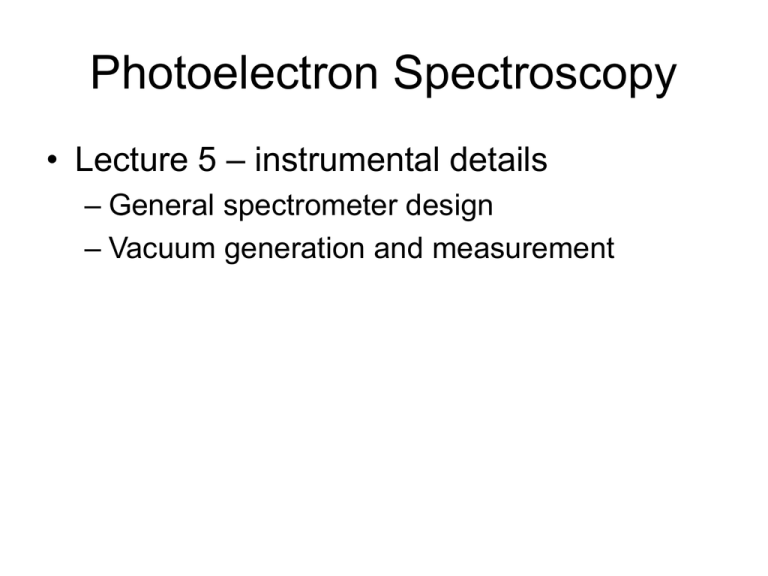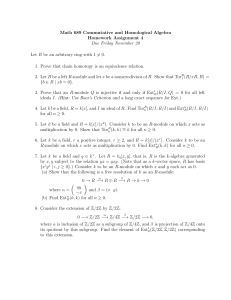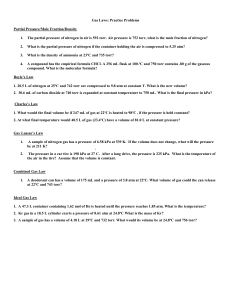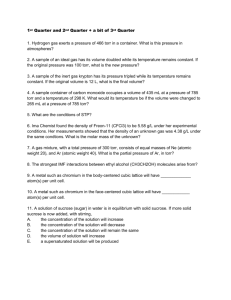Instrument Design; Vacuum Generation and Measurement
advertisement

Photoelectron Spectroscopy • Lecture 5 – instrumental details – General spectrometer design – Vacuum generation and measurement Required spectrometer components Photon Source Sample Electron Amplifier, Counter, and Recorder Electron Kinetic Energy Analyzer Vacuum Pumps Electron Detector Spectrometer design considerations • What type of samples are of interest? • What resolution is required to gather the information of interest? – Resolution of this experiment is always instrumental based. – Experimental resolution is directly correlated with electron kinetic energy. • What can be done to increase experimental sensitivity? – Often a pay-off between resolution and sensitivity. • What is it going to cost? – Money for constructing spectrometer – Pumping requirements – Time for data collection Sample Considerations Gas-Phase Photoelectron Spectroscopy • Atoms, neutral Molecules, anions, clusters, etc. • For neutral molecules, need a vapor pressure of ≈10-4 torr in high vacuum at temperatures <≈ 500 °C • “Hot” molecules will have more complicated vibrational/rotational contributions. Condensed-Phase Photoelectron Spectroscopy • Film on conductive surface • For valence spectroscopy, need uniform film •(vapor deposition, SAMs, spin coating) Why do we need vacuum? • Low pressure is required for operation of electron detectors • Pressure must be low enough to allow mean-free-path of electrons through the analyzer • Pressure must be low enough that gas-phase samples are volatile • Ultra-high vacuum is required to lower surface contamination for condensed-phase spectroscopy • Vacuum pump: a pump that removes gas molecules from a sealed volume in order to leave behind a partial vacuum Vacuum Ranges Atmospheric pressure 760 torr Low vacuum 760 to 25 torr Medium vacuum 25 to 10-3 torr High vacuum 10-3 to 10-9 torr Ultra high vacuum 10-9 to 10-12 torr Extremely high vacuum <10-12 torr Examples of vacuum levels Vacuum cleaner 600 torr Liquid ring vacuum pump 24 torr Freeze drying 1 to 0.1 torr Rotary vane pump 1 to 10-3 torr Incandescent light bulb 0.1 to 0.01 torr Thermos bottle 10-2 to 10-3 torr Near earth outer space 10-6 torr Turbopumped vacuum chamber 10-6 to 10-9 torr Cryopumped surface science chamber 10-9 to 10-11 torr Pressure on the moon 10-11 torr Interstellar space 10-17 torr How Low Must Pressure be for a Surface to be “Clean”? If “sticking coefficient” S = 1 And pressure = 2.5 x 10-6 Torr A monolayer will form in 1 second Lower pressure to ~ 10-9 Torr A monolayer forms in 1,000 seconds S is usually <<1 Methods for Vacuum Generation: 1 • Positive displacement: use a mechanism to repeatedly expand a cavity, allow gases to flow in from the chamber, seal off the cavity, and exhaust it to the atmosphere (rotary vane, scroll pump, roots blower) Methods for Vacuum Generation: 2 • Momentum transfer: use high speed jets of fluid or rotating blades to knock gaseous molecules out of the chamber (diffusion, turbomolecular) Methods for Vacuum Generation: 3 • Entrapment: capture gases in a solid or absorbed state (cryopumps, getters, ion pumps) Vacuum measurement Bourdon gauge > 10-2 torr McLeod gauge > 10-4 torr thermocouple gauge 760 - 10-3 torr ion gauge 10-3 - 10-10 torr





